How to catch bass bank fishing during the summertime and more...
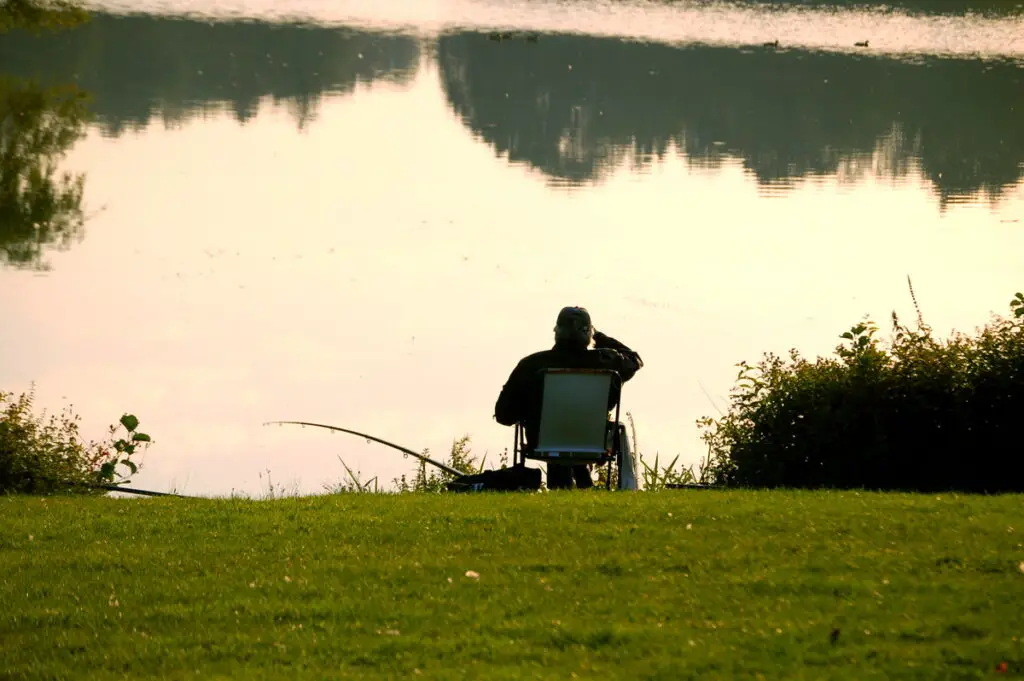
Bank fishing for bass during the summer can be extremely difficult especially of you you’re battling the sweltering heat of summertime. However, it’s not impossible to catch a monster bass from the bank. And in this article, you’re going be given the blueprint on how to do exactly just that.
Summer bass bank fishing needs to be handled a certain way. You just don’t go to the lake at any time and expect to catch giant bass. So before you go do the following things. Choose a time where you’re given the greatest chance to catch a bass, which would be in the morning or at night. Pack light and mobile by going out with only four rod/reel setups. Come ready and with the right type of summertime baits such as topwater baits, hard plastic/moving baits, various bass jigs, Texas rigged soft plastic baits, and a drop shot set up. Then, you’ll need to target the best locations that have the strongest chance of harboring a big bass. Finally, you’ll want to scan that area with a portable fish finder that you cast from the bank. When you put all the variables together it will give you the best opportunity to catch the fish of a lifetime.
Have you ever been in a position where you had a morning to burn but couldn’t get on the lake with a boat or kayak? Well don’t sweat it. In the next few minutes, I’m going to give you all my personal summertime blueprint on how to catch bass from the bank.
WARNING: There’s a lot of information about this subject you’ll probably want to come back to. No one expects you to remember all these tips. We know your time is precious, so we really tried to over-deliver in value for you. Additionally, we frequently update reports like this, so you’ll want to stay up to date with any changes or additional tips we include for you.
We found that the easiest way to save and bookmark this report so you can come back to it later is to share it on your favorite social media platform, especially if you use your phone to get important tips like the ones in this report here…
Click on your favorite social media buttons to remember this page now!
My Best Summer Bass Lures From The Bank
The best baits that will catch bass during the summer will be the ones that are extremely loud, fast and obnoxious, or will be subtle, small and inconspicuous.
Topwater Baits:
Frogs
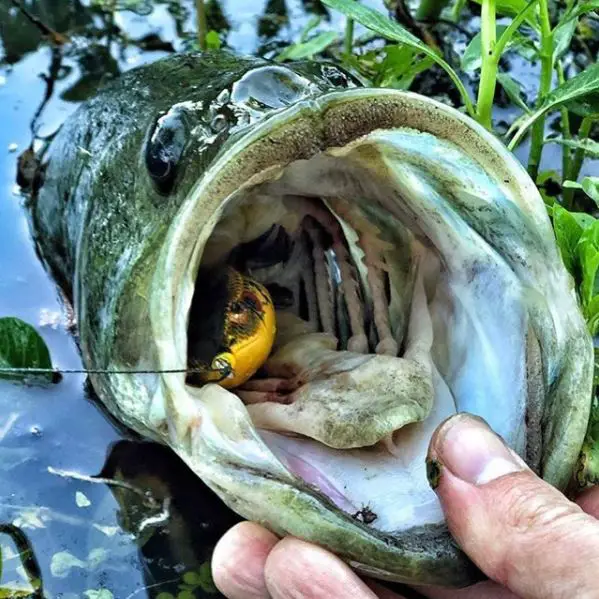
Frogs – Fished over heavy cover or parallel to the bank. Frogs are one of the bass’ favorite tasty meals.
Colors you need: You only really need to carry three colors of frogs. White, green, black.
Blueprint for success: Work the frogs as close to the bank or structure as possible. If you’re targeting any overhanging structure such as a dock over a tree, try to skip your frog lure into the deepest, darkest area that structure has to offer. Often the biggest bass will be positioned in the very back.
Buzzbaits
Buzzbaits – Loud, big, obnoxious. Three words that summarize this bass bait perfectly. There is really no natural prey the buzzbait mimics, but that doesn’t stop the huge bass from crushing these lures.
Colors you need: White/shad colored for morning use. Black for when you’re fishing at night.
Blueprint for success: Also work as close to the bank as possible, or around or over any hard structure. Best used during windy conditions. A helpful tip to remember… as you’re retrieving your buzzbait and it hits an object, give your rod tip a little pop upward to make it move just a tic bit faster. Often bass will instinctually crush this lure.
Poppers

Poppers – Are basically the opposite of a buzzbait. This bait excels when used during calm windless conditions.
Colors you need: White/shad colored for morning use and when targeting points or the end of docks. Bluegill colors also work great when fished toward the backs of coves, around tullies, alongside grass mats or over submerged vegetation.
Blueprint for success: Poppers are fantastic little lures that can produce HUGE bass during the summer. In the early summer, bass will target bluegill beds. Those bluegill are very territorial and are constantly chasing each other away from their beds. The beds have a softball-sized crater and are bunched close together.
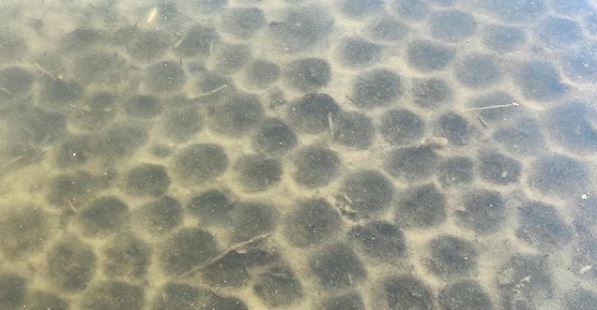
The best way to fish for bass around these beds is to fish a bluegill colored popper 10-15-feet away from the beds. Be sure to vary your cadence of popping and gurgling your lure. Opportunistic bass will quickly gobble up what they think is a small bluegill not paying attention.
Later in the summer you’ll have success with fishing a shad colored popper over points or around structure if you see bass chasing fish in open water.
Target your popper edges of around grass beds, over submerged vegetation patches, or along side over pieces of exposed structure.
Moving Baits:
Swim jigs
Swim jigs – Providing bites all year long, swim jigs will give you the best action during the summer. Bass during the summer will slowly make their way back to the shallow areas. But they won’t target just any shallow area. It needs to meet three requirements before a bass will consider staging shallow, I call it the Swim Jig Triad: darkness or shade, a good spot to ambush prey, and bluegill or bream present in the area.
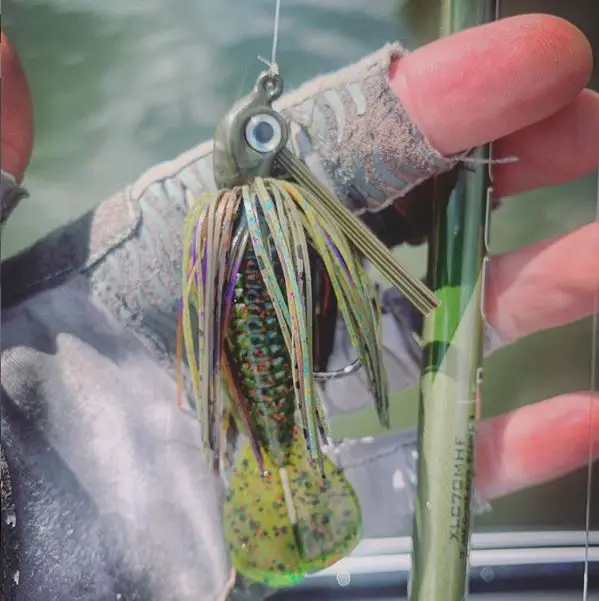
So whether you’re walking the bank or at home on Google Maps, look for places that meet those criteria.
Colors you need: Bluegill or bream colored. Often a simple green pumpkin pepper jig paired with a black and blue flake craw trailer works like a charm.
Blueprint for success: Fishing a weedless swim jig allows you to cover water very fast, efficiency, and will rarely snag up. In the dog days of summer the water can be very clear, which is where the swim jig shines. It can be fished aggressively and still look non-threatening. If you can find a shallow area with Swim Jig Triad plus any wind blowing against the shore it is a recipe for absolute success.
Football/ Flipping Jigs
Football or Flipping Jigs – Football or flipping jigs can work exceptionally well especially in the late summer. Deep water bass will slowly make their way to the mouths of coves and start to stage there before fall. But you can also add in other large structures extending out into the main lake.

I recommend the 1/2-ounce tungsten football jig made by Mythik Lures. Their tungsten jigs have some great features such as, they have custom skirt colors for any type of water, they are hand-tied so the skirt doesn’t fall off after a single season, and the jig head color is baked on for extra durability. Best of all these jigs can be flipped too, plus the football shape head resists getting hung up! These jigs are awesome and is perfect for both beginners and veteran anglers, and it’s conveniently available on Amazon.
Click Here to read all the reviews from REAL Amazon customers for this product.
Colors you need: green pumpkin, watermelon red, black and blue.
Blueprint for success: Look for areas that offer shade, current and good ambush spot. Docks, bridge pilings, vertical timber, wooden laydowns, floating vegetation mats and overhanging trees are good locations to target.
Other great options to flip your jig is along or around areas of chunk rock or construction concrete mound.
The closer you flip your jig to the structure the better.
Squarebill crankbaits
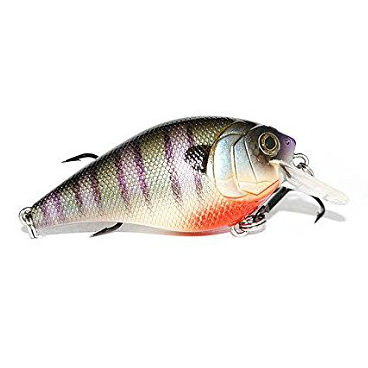
Squarebill crankbaits – Shallow running squarebill crankbaits are perfect for covering water when you’re trying to develop a pattern. Often the bass will either bite or slap at the lure giving away it’s hiding spot. Take note how far off the bank the lure was attacked, what speed, and what was the surrounding structure.
Colors you need: White/shad colored for morning use and when targeting points or the end of docks. Bluegill colors also work great when fished toward the backs of coves, or around vegetation.
Blueprint for success: If the body of water you’re fishing has exposed structure such as boulders, flooded brush, or points then reach for a squarebill crankbait. They work even better if it’s windy out.
These loud, fat wobbling lure work great when targeting the farthest corner of a dock. Many times the dock owner will intentionally sink brush piles in front of their dock. By trying to cast way out in front of the dock it will give you the chance to target these bass.
If you’re walking the bank and you see some isolated cover such as a boulder, a stump or something else often a bass will be hiding in any shadow its making.
When fishing any isolated piece of cover, make sure you cast past the cover and work your bait over it, being sure to bump, grind, or bank your crankbait into it.
Soft Plastic Baits
Soft plastic swimbaits
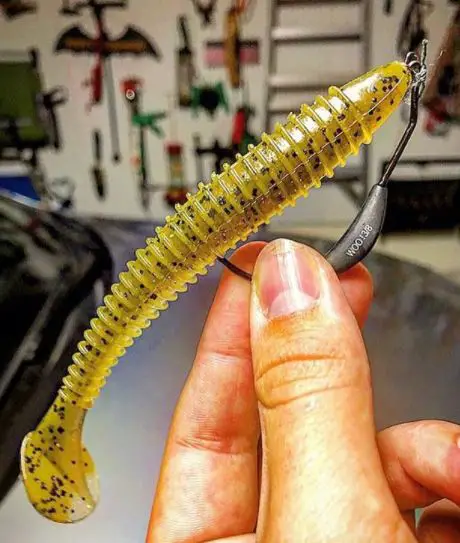
Soft plastic swimbaits – During the summer, most bass will prey upon shad. And if they’re not eating shad, chances are they are gulping down small bluegill or crappie. Therefore, it goes without saying you need to know what prey items the bass are feeding on in the lake and try to match the hatch as close as possible.
Colors you need: Shad patterns – ghost shad, pro-blue shad, salt-and-pepper shad. Bluegill colors-watermelon seed, pumpkin seed, baby bass.
Blueprint for success: Locate any current, runoffs, or any windblown points and fish that. Often shad will congregate around these locations try to feed on any microscopic organisms.
Often around the points you may see schooling bass attacking shad near the surface. The morning is normally the best time of day where you’ll see this.
Make as long as a cast you can, and swim the bait through the school. If you get no bites, as you swim your bait through the school stop reeling and let your swimbait “die”. The sudden falling swimbait will be often attacked by a bass thinking it was an injured shad.
Drop shot rig
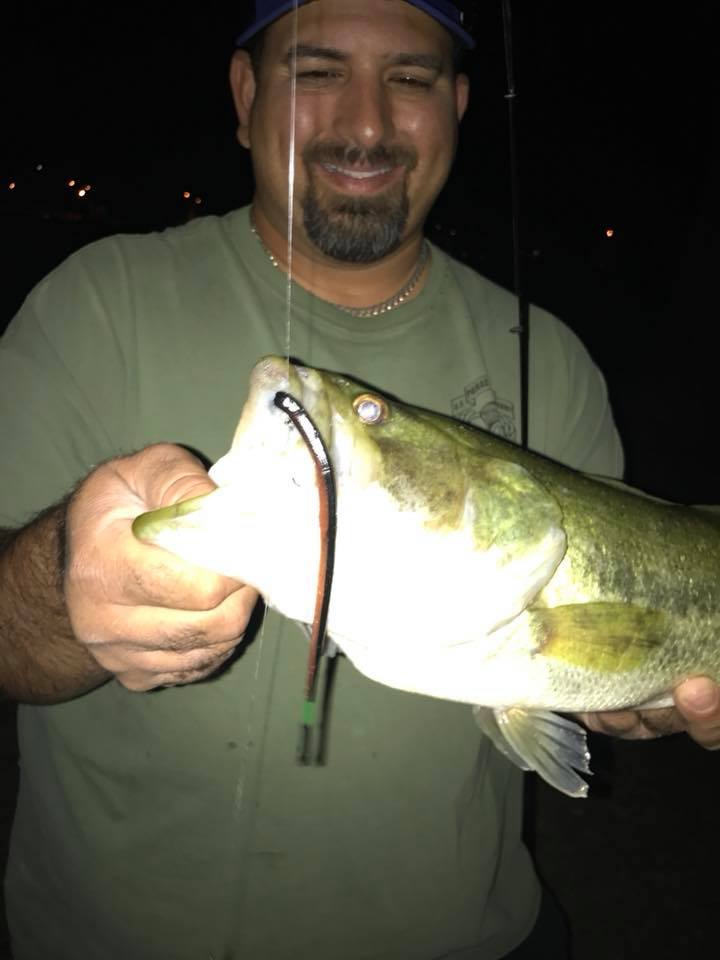
Drop shot rig – Fishing a drop shot from the bank during the summer can be one of the most effective ways to catch fish. Its versatility is unmatched because you are only limited by way bait you thread on the hook.
The drop shot rig is best known for catching finicky bass. And the drop shot worm is the bait that makes it happen.
Your typical drop shot worm will be 4-to-6-inches in length, thin, and very flexible.
Any twitch of the rod tip, or subtle movement of current will quickly bring the worm to life.
Colors you need: green pumpkin, watermelon, morning dawn, margarita.
Blueprint for success: In the morning, if a bass misses your topwater lure, quickly follow up by throwing a dropshot worm right behind it. Chances are that aggressive bass that swiped at your topwater lure will came back and eat that worm.
But here’s a tip – make sure your drop shot worm color is similar to the color of your topwater bait.
After the morning bite has slowed, be sure to pitch and flip your drop shot worm around pieces of structure that create large shadows.
Rotate different bait if you’re not getting any bites.
Have you ever wanted to learn all the secrets on how to fish the drop shot rig? Well, you’re in luck, I made an all-in-one drop-shot fishing blueprint that gives you everything thing you need to know to make you more efficient drop shot angler on the water. If you want to know about the top drop shot fishing techniques, then click here to learn more.
Texas rigged worms or Senko
Texas rigged worms or Senko – Since the introduction of some of the newest hotshot finesse fishing techniques many anglers forget about the Texas rigged soft plastic worm. However, this tried and true technique can boat you a ton of bass.
Another reason the Texas rigged worm outperforms most during the late summer is because a lot of the fish have gotten used to seeing large crankbaits. So if they see a Texas rigged worm, it’s something different.
A Texas rig is also great during the summertime because it doesn’t get hung up in the weeds.
The larger the bait, the bigger the bass… normally.
In the summertime a bass’ metabolism is going bonkers. So don’t be shy about throwing a large bait. Many anglers are hesitant to throw such a large bait and so bass are used to seeing big baits like that.
The best sizes for soft plastic worms would be a 7-to-10-inch curly tail worm or 7-inch Senko.
These baits are not subtle, but you will eventually catch a bunch of really good fish on them.
Colors you need: green pumpkin, watermelon red, black and blue
Blueprint for success: Large curly tail worms and large Senkos work amazing during early morning, late evening or at night.
Since you’re using a large bait, don’t sit on any one spot for a long period of time. Usually there will be only a couple of big fish on a good spot, so make sure you move around. You can always come back to that spot later.
What’s The Best Weight For A Texas Rig For Summer Bank Fishing
Lead is good, tungsten is better. In a pinch a lead bullet weight will work, however if you have the option to use a tungsten weight. Its nearly 40% more dense than lead and it beats out lead’s ability to transmit vibration, bottom contour changes, and detect subtle bites.
That being said, you shouldn’t need anything heavier than 1/4-ounce. A good rule of thumb is use the lightest weight possible all while maintaining contact with the bottom fo the lake.
If you use too heavy of a weight, you’ll likely get hung up a lot.
Best Rod/Reel Set Up for Summer Bank Fishing
In bass fishing you know the bass don’t move around that much, so you’ll need to stay mobile. Bringing a rod that can serve multiple functions is very important.
It’s recommended only to bring 4 rods:
Rod 1): “Heavy/Jig Rod”, baitcasting rod, 7′ 2″ medium-heavy rod with fast tip for frogs, buzzbaits, flipping jigs.
Rod 2): “Topwater Rod”, baitcasting rod, 6′ 6″ medium action, extra fast tip rod for topwater poppers, squarebill, spinnerbaits, swim jigs.
Rod 3): “Senko and Texas Rig Rod”, baitcasting rod – 6′ 6″ medium action, extra fast tip rod for Texas rigs, smaller jigs.
Rod 4): “Drop shot rod”, spinning rod, 7′ 2″ medium action rod with an extra fast tip.
Best Place to Catch Bass From The Bank During the Summer
One of the most important things to understand is to exploit the bass is seasonal movements throughout the year. Remember bass will come in shallow in the spring to spawn and will be shallow first thing in the morning and evening during the summer.
Bass will be deeper once the sun gets above the tree line during the summer and during the deep part of winter.
Once the sun is above the tree line, look for structure that provide shade. Not all bass will retreat deep, some will stay shallow and hunker down in the shade.
Look for “signs of life”
When I say “signs of life”, I mean I’ll look for bass behavior on the lake.
Before you even get close to the water edge, hang back about 50 feet and just observe the lake for a few minutes. Sip your coffee, take a deep breath and just observe nature.
Often the bass will tell you where you are and what they are feeding on by watching for topwater blowups and swirls around the different structures.
Look for other natural ques such as herons standing as still as a statue on the water edge waiting to quickly pick off small bait fish swimming by. Bass are frequently nearby feeding on these small fish.
Wild game trails that will lead to the water edge. Many times, game trails will have exposed rocks due to the foot traffic. If the rocks extend into the lake, bass like hard bottoms over soft bottoms.
Vegetation such as floating grass mats, lily pads, or tall tullies will attract bluegill, sunfish, or tilapia. If they are around, you hear a sucking or a popping sound of these little fish sucking up insects from the surface.
Finally, observant for any type of runoffs or small creeks that will flow into the water creating current. Baitfish love these areas because they will often carry other insects into the lake. Bass will follow the baitfish and pick them off since they’ll be distracted.
Prime fishing spots – natural and manmade
There are sooo many stops your lake may offer, natural and manmade. Below we’re giving you a good list of potential spots to fish so you don’t waste your time on the water. Please keep in mind your lake may have even more spots than what is seen here.
I’ll also look for natural changes such as points and embankments that have steep drop offs versus embankment that gradually going into the lake. Changes in rock size also can attract fish. Basketball-size chunk rock that transitions to pea gravel is a good spot to fish.
Here is a list of some other natural spots you should look for:
· Points
· Grass mats, lily pads
· Weed lines
· Runoffs
· Inflowing creeks
· Bluff walls
· Fallen trees into the water
· Flooded brush
· Rock piles that spill into the lake
· Isolated boulders or stumps
Other great fishing spots can be manmade. So, be sure to look for evidence of previous construction sites near or around the waterline! Sometimes you’ll see large concrete pilings where construction crews wanted to build a bridge or something and for one reason or another left it abandoned. Bass love these types of vertical structures because they can hide around it and it provides the perfect ambush point.
Here is a list of some other man-made spots you should look for:
· Dams
· Bridge pilings
· Docks
· Boat ramps
· Submerged roads
· Buoy lines
· Rainwater runoff canals
· Drainage pipes
· Fountains
[HUGE] Bank Fishing Tip – Use a Portable Fish Finder

You may have seen portable fishing finders (or ‘fish sonar’) on the market recently and without a doubt they absolutely changed bank fishing forever. To get the best result out from your time on the water, you need a fish sonar that can tell you exactly where the fish are hiding and what the surrounding underwater structure looks like
Having access to a portable fish finder can change the way you fish a location and can make the difference between catching nothing to filling up your stringer.
However, in order to increase your chances of catching a fish the sonar unit you choose has to actually work as advertised, easy to use and last a full day of fishing, so make sure you read the good and bad reviews of the sonar you’re considering.
Lucky for you, I written a complete hands-on report of all top 6 portable fish finders for bank fisherman, where I outlined everything, even the durability issues that I ran into. If you you want to catch more fish from the bank, then you need to check that report.
BONUS TIP - How to Make Rod Holders for Bank Fishing
how to make rod holders for bank fishing
FAQ
What’s the best way to approach a bank to go fishing?
Once you have an idea where you’re going to fish it’s important to think about how you are going to fish it.
I always start by stopping approximately 25 feet before the water edge and casting out a popper just to make sure there is no bass hanging out where I plan to start my fishing adventure for the day.
From there I will typically start by fan casting closest to the bank nearly parallel and out to only 45 degrees from where I’m standing. Very rarely will I cast straight out to the middle of the lake and bring it in.
How long do I stay fishing in the same spot?
I will give myself approximately 5 to 10 minutes at each spot sometimes. I will set a timer on my phone to queue myself to move.
Make sure you do your homework before hitting the water ask around to see what colors will work. I found that most anglers will give up their successful colors before they give up their favorite baits.
Is summer bass fishing after heavy rain any good?
A heavy rain will do several things to the lake.
First, it will increase oxygenation by falling directly on the lake and rainfall will create runoffs into the lake that also improve oxygenation of lake.
Rainwater runoffs, will wash down a ton of nutrients and small insects into the lake. This sets off a chair reaction.
Nearby baitfish, such as bluegill and shad will start to feed off this new food source. Bass will sense the feeding frenzy and will start to gobble up baitfish that are not paying attention.
Finally, after a heavy rain the disturbed water may be a little cloudy. This means the odds of a bass eating your lure are increased because they cannot detect you.
Checkout These Other Summer Fishing Articles...
- Complete 5-Step Formula For BASS FISHING DOCKS
- The 7-step Secret Formula for BASS FISHING LEDGES – Even a Complete Fishing Noob Can Use and Be 100 Times More Potent Than the Best B.A.S.S. Professional!
- Top 25 Summer Bank Fishing Tips (Never Get Skunked Again)
- Bass Fishing In Heavy Grass? [17+ Mistakes To Avoid]
- 7 Top Secret Weedless Bass Lures for Flipping into Heavy Grass -Exposed!
- How To Fish A Crankbait [TOP 10 Essential Secrets To Catching Bass With A Crankbait]
- 15 Best Deep Diving Crankbaits [2023 Buyers Guide – Which to Buy & Avoid]
- Fish a Flutter Spoon The RIGHT way... like the Pros... And Do It TODAY!
- NEW and truly "no brainer" (yet usually overlooked) way to MASTER SOFT PLASTIC PADDLE TAIL SWIMBAITS and increase the amount of bass you catch 100% or more... automatically!
- Top 5 questions and challenges every about hair jig fishing... AND how to overcome common problems most anglers encounter (and then prematurely quit).
- Top 10 Best Jigs For Bass Fishing [Insiders Only]
- Avoid this ONE Texas rig fishing NIGHTMARE - And increase your Texas rig fishing expertise FAST!
- 31 Best Tips for Bass Fishing At NIGHT (Complete Guide)
- 2023 Buyers Guide Best GREEN FISHING LIGHT [LED FISHING LIGHTS Reviews & Tips]
- Dock Lights For Night Fishing [Best Products, Secrets, & Tips]
In summary…
There you have it, they is my personal blueprint for successful bank fishing during the summer. I know Included a TON of information here so I hope you didn’t mind.
I just hope you catch a monster bass that you’ll remember for ever.
Until next time. Take care and tight lines!

